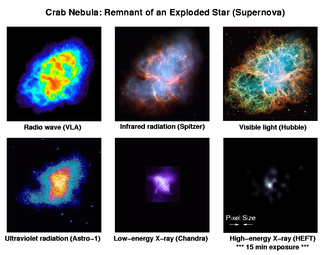X-ray astronomy
X-ray astronomy is a branch of astronomy that studies astronomical objects at X-ray wavelengths. Unlike visible light, which gives us a familiar view of the universe, X-rays are absorbed by the Earth's atmosphere, necessitating X-ray telescopes and detectors to be placed on satellites in space to observe the X-ray universe. X-ray astronomy reveals the high-energy phenomena in the universe, such as black holes, neutron stars, and supernova remnants, which emit strongly at X-ray wavelengths.
History
The field of X-ray astronomy began in the early 1960s with the first successful detection of X-rays from an astronomical source other than the Sun. In 1962, a team led by Riccardo Giacconi discovered a cosmic X-ray background and the first X-ray source outside the Solar System, Scorpius X-1, using a sounding rocket. This discovery opened a new window to the universe, leading to the development of space-based X-ray observatories.
Observatories
Several X-ray observatories have been launched to study the cosmos in X-ray wavelengths. Notable examples include:
- Chandra X-ray Observatory, which provides high-resolution imaging and has been operational since 1999.
- XMM-Newton, launched by the European Space Agency (ESA) in 1999, known for its large collecting area and spectroscopic capabilities.
- Swift Gamma-Ray Burst Mission, which, in addition to studying gamma-ray bursts, has capabilities for observing X-ray sources.
- NuSTAR (Nuclear Spectroscopic Telescope Array), launched in 2012, is the first focusing hard X-ray telescope in orbit.
These observatories have significantly advanced our understanding of the high-energy universe.
Scientific Goals
X-ray astronomy aims to address several key scientific questions:
- The nature and physics of black holes and how they accrete matter.
- The properties and behavior of matter under extreme gravitational and magnetic fields, as found in neutron stars.
- The mechanisms behind high-energy phenomena such as supernovae, gamma-ray bursts, and cosmic rays.
- The structure and evolution of the universe, including the role of dark matter and dark energy.
Challenges
X-ray astronomy faces unique challenges, including:
- The difficulty of focusing X-rays, which requires special telescope designs such as grazing incidence mirrors.
- The need for space-based observatories, as X-rays are absorbed by the Earth's atmosphere.
- The harsh environment of space, which can affect the longevity and performance of instruments.
Future Prospects
The future of X-ray astronomy looks promising, with several missions planned or proposed that aim to further our understanding of the universe. These include the Athena (Advanced Telescope for High ENergy Astrophysics) mission by ESA, set to launch in the 2030s, and the proposed Lynx X-ray Observatory, which aims to provide unprecedented resolution and sensitivity.
Transform your life with W8MD's budget GLP-1 injections from $125.
W8MD offers a medical weight loss program to lose weight in Philadelphia. Our physician-supervised medical weight loss provides:
- Most insurances accepted or discounted self-pay rates. We will obtain insurance prior authorizations if needed.
- Generic GLP1 weight loss injections from $125 for the starting dose.
- Also offer prescription weight loss medications including Phentermine, Qsymia, Diethylpropion, Contrave etc.
NYC weight loss doctor appointments
Start your NYC weight loss journey today at our NYC medical weight loss and Philadelphia medical weight loss clinics.
- Call 718-946-5500 to lose weight in NYC or for medical weight loss in Philadelphia 215-676-2334.
- Tags:NYC medical weight loss, Philadelphia lose weight Zepbound NYC, Budget GLP1 weight loss injections, Wegovy Philadelphia, Wegovy NYC, Philadelphia medical weight loss, Brookly weight loss and Wegovy NYC
|
WikiMD's Wellness Encyclopedia |
| Let Food Be Thy Medicine Medicine Thy Food - Hippocrates |
Medical Disclaimer: WikiMD is not a substitute for professional medical advice. The information on WikiMD is provided as an information resource only, may be incorrect, outdated or misleading, and is not to be used or relied on for any diagnostic or treatment purposes. Please consult your health care provider before making any healthcare decisions or for guidance about a specific medical condition. WikiMD expressly disclaims responsibility, and shall have no liability, for any damages, loss, injury, or liability whatsoever suffered as a result of your reliance on the information contained in this site. By visiting this site you agree to the foregoing terms and conditions, which may from time to time be changed or supplemented by WikiMD. If you do not agree to the foregoing terms and conditions, you should not enter or use this site. See full disclaimer.
Credits:Most images are courtesy of Wikimedia commons, and templates, categories Wikipedia, licensed under CC BY SA or similar.
Contributors: Prab R. Tumpati, MD






